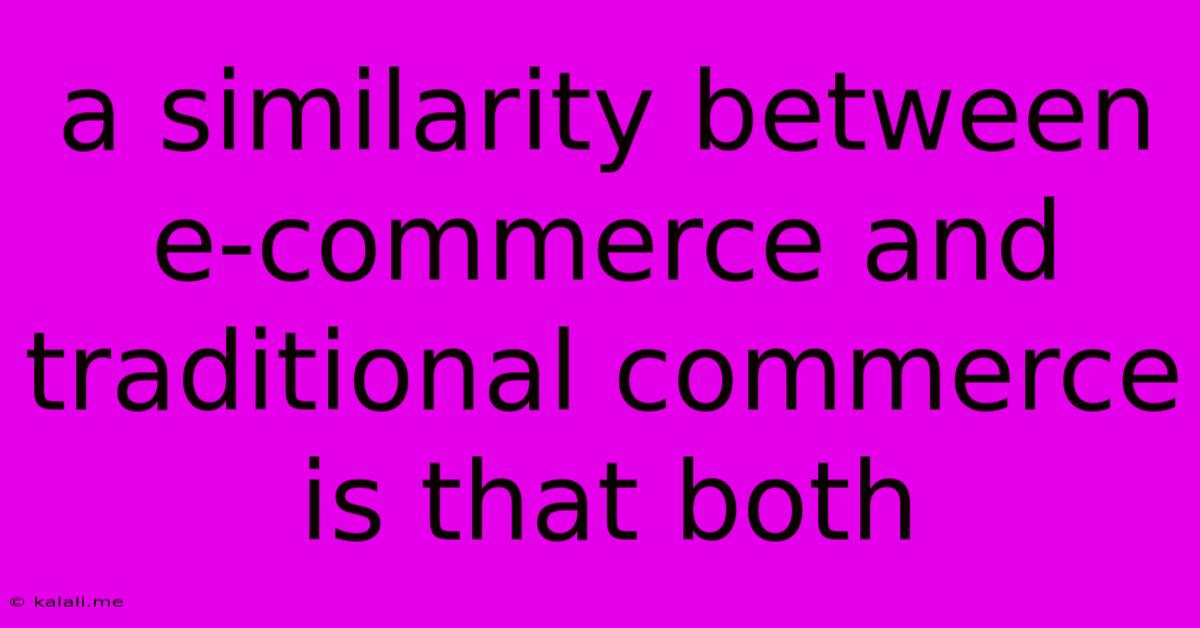A Similarity Between E-commerce And Traditional Commerce Is That Both
Kalali
Jun 15, 2025 · 3 min read

Table of Contents
A Similarity Between E-Commerce and Traditional Commerce: Both Rely on Strong Customer Relationships
The rise of e-commerce has dramatically reshaped the retail landscape, but beneath the surface of digital storefronts and online marketplaces lies a fundamental similarity with its brick-and-mortar predecessor: both rely heavily on building and maintaining strong customer relationships. While the methods may differ significantly, the core principle of fostering loyalty and repeat business remains constant. This article will explore how both e-commerce and traditional commerce leverage customer relationships for success.
Building a thriving business, whether online or offline, hinges on understanding and meeting customer needs. This involves more than just making a sale; it's about creating a positive and lasting impression that encourages repeat purchases and referrals. Let's delve into the specifics:
Understanding Customer Needs: The Foundation of Success
In traditional commerce, understanding customer needs often involves direct interaction. Sales associates engage with customers, assess their needs, and offer personalized recommendations. This face-to-face interaction allows for immediate feedback and adjustments to the sales approach. Data collection might involve loyalty programs, customer surveys, or simply observing customer behavior in the store.
E-commerce, on the other hand, relies on data-driven insights to understand customer needs. Website analytics, purchase history, and customer feedback mechanisms like reviews and online surveys provide valuable data. Personalization is achieved through targeted advertising, personalized email marketing, and recommendation engines, mimicking the personalized approach of a knowledgeable sales associate. Understanding customer preferences through data analysis is crucial for successful online businesses.
Building Trust and Loyalty: The Key to Repeat Business
Trust is paramount in both models. In traditional commerce, trust is built through consistent product quality, reliable service, and positive in-person interactions. A friendly and helpful staff can significantly impact a customer's perception of the brand. A physical presence provides a sense of security and assurance, making it easier for customers to build confidence in the business.
In e-commerce, trust is established through factors like secure payment gateways, transparent return policies, positive customer reviews, and a well-designed website that builds confidence. Building a strong online reputation is crucial for e-commerce success. Active community engagement, responsive customer service, and consistent brand messaging all contribute to establishing trust in the digital space. Security measures and transparent processes are paramount to ease customer concerns and drive conversions.
Customer Service: A Differentiator in a Competitive Market
Excellent customer service is a significant differentiator in both traditional and e-commerce models. In traditional commerce, responsive and helpful staff can resolve issues quickly and efficiently, leading to higher customer satisfaction. A positive experience often leads to repeat business and positive word-of-mouth referrals.
Similarly, in e-commerce, responsive customer support channels – such as live chat, email, and social media – are crucial. Quick resolution of issues, proactive communication, and personalized interactions significantly impact customer satisfaction and loyalty online.
Conclusion: The Enduring Power of Customer Relationships
Ultimately, the similarity between e-commerce and traditional commerce lies in their dependence on cultivating strong customer relationships. While the tools and methods may vary, the underlying principle of understanding customer needs, building trust, and providing excellent customer service remains the key to success in both digital and physical marketplaces. Businesses that prioritize these elements are better positioned for long-term growth and profitability, regardless of their chosen sales channel.
Latest Posts
Latest Posts
-
What Is The Lcm Of 4 6 And 10
Jun 16, 2025
-
What Is The Prime Factorization Of 95
Jun 16, 2025
-
What Country Is Lake Victoria Located In
Jun 16, 2025
-
If Abc Is An Equilateral Triangle
Jun 16, 2025
-
What Is A Factor Of 44
Jun 16, 2025
Related Post
Thank you for visiting our website which covers about A Similarity Between E-commerce And Traditional Commerce Is That Both . We hope the information provided has been useful to you. Feel free to contact us if you have any questions or need further assistance. See you next time and don't miss to bookmark.